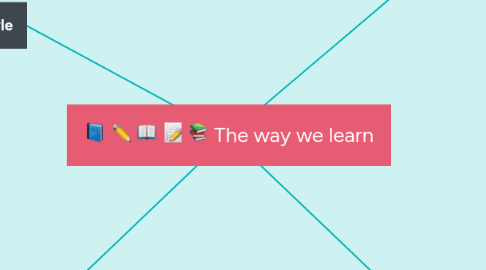
1. Learning style
1.1. Learners have different learning styles
1.1.1. Visual learning
1.1.1.1. There are pictures in the classroom walls
1.2. Authentic learning
1.2.1. The exploration of technology to bring real_world to the classroom takes place
1.3. Generational learning
1.3.1. The teacher_learner relationship needs a common ground
1.4. Adragogy
1.4.1. Learners are prepared on the journey to adulthood
1.5. Visual learning style
1.5.1. Classrooms are made of different artifacts,t o accommodate visual learners
1.6. Collaborative learning
1.6.1. Most learners do not do their part in group projects.
1.6.2. Technology projects are given in a group of 5 to 8 learners,to work together
1.7. Active learning
1.7.1. Learners are given a chance to present their work to the rest of the class
1.8. Problem based learning
1.8.1. The problem to be solved is presented to learnees
2. 21st century learning
2.1. Video based learning
2.1.1. The are no digital tools,to perform video based learning
2.2. Connectivism
2.2.1. There is no internet connection in our learning ecosystem
2.3. Maker spaces
2.4. Multimedia learning
2.4.1. The computers that were available has been stolen
2.5. Gaming and gamification
3. Constructivism
3.1. Metacognition
3.1.1. Imagining and creating thought around content and skills us approached
3.2. Motivation and learning
3.2.1. Learning is made enjoyable and stimulating
3.2.2. There are award giving to the best performing learners
3.3. Constructionism
3.4. Cognitive constructivism
3.4.1. Learners build their own language from classroom experience
3.5. Behaviorisms
3.5.1. Punishment is done to learners who misbehave
3.6. Bloom's taxonomy
3.6.1. Revision is done to test if learners remember the information taught
3.7. Situated cognition
3.7.1. The knowledge of learners is constructed within and linked to the activity and content learned
3.8. Social constructivism
3.8.1. Learners create meaning through their interaction
4. Learning theories
4.1. Social learning theory
4.1.1. The importance of observational learning is stressed
4.1.2. Modelling the behaviors and emotional reactions of others
4.2. Chaos theory
4.3. Cognitive load theory
4.3.1. Attention is directed to activities that promotes learning
4.3.2. Learning outcome is provided
4.3.3. Examples and analogies are provided
4.4. Activity theory
4.5. Cognitive development theory
4.5.1. Grade 9 learners think logically about concrete objects
